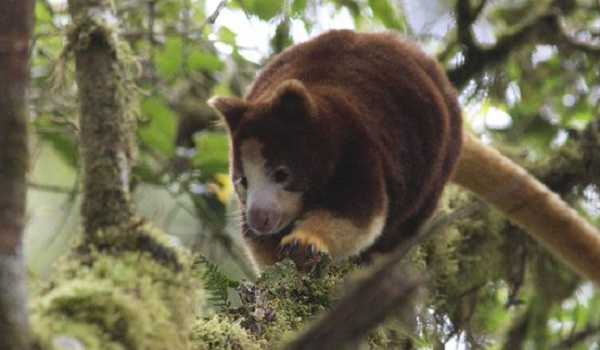Samikhsya Bureau
The tree kangaroo which is only found in the rainforests of Australia, West Papua, and PNG is threatened due to hunting and habitat destruction.
But now the local and indigenous people of PNG, who typically hunted the marsupial, are acting as custodians of the ancient rainforests by promoting the sustainable use of the land and the management of what is now a conservation area.
Looking like a cross between a kangaroo and a lemur, they have adapted to life in the trees, with shorter hind legs and stronger forelimbs for climbing. Despite weighing up to 16kg, tree kangaroos are remarkably elusive, and often invisible high in the forest canopy.
In Papua New Guinea, tree kangaroos are the flagship species for the rare cloud forests – a high elevation rainforest characterised by low-level cloud cover. As a flagship species, the health of the tree kangaroo reflects the health of their wider ecosystem. By focusing on and achieving conservation of the tree kangaroo, the status of many other species that share its habitat – or are vulnerable to the same threats – may also be improved.
Found from the western side of Papua New Guinea to the eastern coast of the Huon Peninsula, many of the 14 known tree kangaroo species call PNG home, living in some of the last undisturbed rain forest habitat in the world.
Papua New Guinea is a cultural and biodiversity hotspot. It has nearly 1,000 indigenous tribal groups who speak more than 850 different languages, accounting for nearly 12 per cent of all existing languages on earth.
Despite its relatively small land area, Papua New Guinea is estimated to contain between five and ten per cent of all floral and faunal diversity in the world.
Working in some of the most remote corners of the planet, local and indigenous communities are advancing innovative sustainable development solutions that work for people and for nature.
Under PNG’s unique land tenure system, more than 90% of all land in the country is held and controlled by customary landowners. As such, the sustainability of conservation efforts depends upon the commitment of local tribes and clans.
In these remote, difficult to access places, work in PNG to save the tree kangaroos is fundamentally about empowering local environmental stewards.
Papua New Guinea’s Huon Peninsula is an extremely rugged mountainous area rising from the famed coral triangle to 4,000-metre peaks, and is blanketed by one of the world’s largest remaining cloud forests.
The peninsula’s Yopno-Uruwa-Som (YUS) region is dotted with 50 remote villages, home to 15,000 people who, under PNG’s customary land tenure system, collectively own and control their entire 1,600km2 landscape.
Rural communities in PNG live a primarily subsistence lifestyle, relying on their natural resources and fertile soil as their ancestors did for generations before them. However, community leaders in YUS noticed worrying challenges that previous generations had never experienced: important resources were becoming scarce.
The landowners of YUS were determined to find a lasting solution and, in 1996, met Dr Lisa Dabek, a conservation biologist studying the endangered Matschie’s tree kangaroo – endemic to the Huon Peninsula. Despite diverse perspectives and interests, they discovered a common objective: protecting the Matschie’s tree kangaroo and its habitat. With this partnership, the Tree Kangaroo Conservation Program (TKCP) was born.
Over the years that followed, the YUS landowners – inspired by respected landowner Mambawe Manaono of Kumbul village – traversed their landscape to advocate for conservation and sustainable use of their forest for the well-being of future generations. Together with TKCP, the landowners had an ambitious goal: collecting land pledges from dozens of clans across YUS and creating the country’s first nationally recognised Conservation Area.
In 2009, with more than 78,000 hectares of land pledged, their goal was achieved and the YUS Conservation Area was established.
(with UNI inputs)



